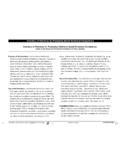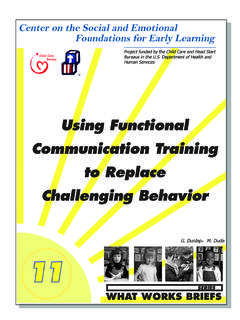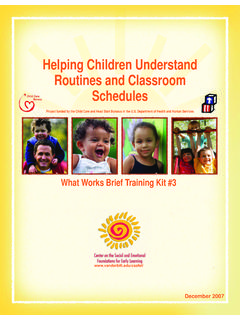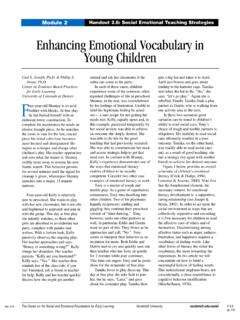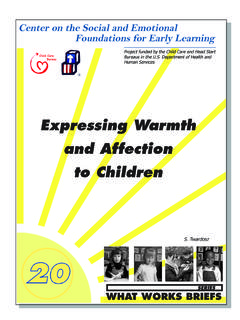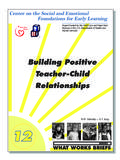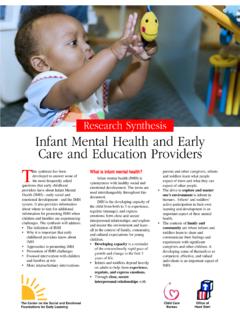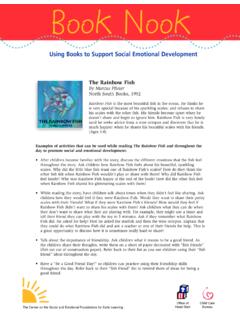Transcription of Using Books to Support Social Emotional …
1 I Have a Little Problem, Said The BearBy Heinz JanischNorth-South Books I Have a Little Problem, Said The Bearfollows a troubled bear ashe tries to find someone to listen to his problem. He visits everyonefrom an inventor to a doctor to find someone who will listen, buteveryone is quick to provide a solution before they even listen to hisproblem! They give him a pair of wings, vitamins, and bear boots but none of these solve the bear s problem. Finally, the bear finds agood listener in an unexpected friend, and solves his problem (thathe is afraid of his dark cave). Children will not only enjoy the story,but also will learn the importance of listening. (Ages 3-5)Examples of activities that can be used while reading I Have a Little Problem, Said the Bearand throughout the day to promote Social and Emotional development: Discuss the idea of listening with the children. Ask what it means to be a good listener. Askchildren if they ever tried to tell someone something and felt like they were not listening to did it make them feel when no one listened?
2 Did they feel frustrated, angry or maybe evensad? Ask the children to think about how it feels when someone does listen to them. For example,how does it feel when they are trying to tell their teacher something and the teacher stops whatshe is doing and listens to them? Do they feel happy, understood and important? Tell the childrenthat you are going to read a book about a bear with a problem. Ask them to listen carefully sothey can figure out what the bear s problem is. Make a large cut-out of a bear similar to the one in the book . As you read through the story, haveeach child pretend to be one of the characters that gives the bear a solution to his problem. Makecutouts of each solution (wings, a scarf, a hat, vitamins, a charm necklace, glasses, honey, andboots) that can be attached to the bear cutout Using Velcro or magnets. As you read each sectionof the story, children can place their props on the bear. Remind children that they will have to begood listeners as you read, so that they know when to give the bear their solution.
3 You could alsohave one of the children pretend to be the bear and use real props for the children to put on the bear. To give children more practice with thinking of good solutions to problems, create an activitywhere children match a problem with a solution. First, remind children how the bear in I Have aLittle Problem, Said the Bearhad trouble solving his problem because no one knew what it was!Introduce the problem solving steps from the CSEFEL website ( ).Provide pictures of different problem scenarios along with pictures of appropriate solutions thatcan be matched. For example, feeling hot/cold (warm/cool clothing), being hungry/thirstyBook NookUsing Books to Support Social Emotional DevelopmentThe Center on the Social and Emotional Foundations for Early Learning Child Care BureauOffice ofHead Start book Nook(food/drink), being sleepy (taking a nap) or being afraid of the dark (night light). Using theproblem solving process, help children identify what the problem is by looking at the pictures andthen choose an appropriate solution.
4 Reading the same book for several days in a row is a great way to provide opportunities for infants,toddlers, and preschoolers to develop a sense of competence and confidence, which is an importantpart of Social and Emotional development. They become able to turn pages, point at and labelpictures, talk about the story, predict what will happen next, learn new vocabulary words, talk abouttheir own experiences in relation to the story and even make up their own story! Try reading I Havea Little Problem, Said the Bearfor several days in a row and use some of the ideas, activities, andteaching opportunities listed below to enhance Social and Emotional Group: Play telephone with a small group of children. First remind the children that they willhave to be good listeners, just like the fly in I Have a Little Problem, Said the Bear. Then explain thatyou will whisper something to one child, and that he or she will pass along the message in awhispering voice to the next child.
5 The message will travel to all of the children, and the last one willannounce the message out loud. Be prepared that it might take a few tries before a message travelsclearly through every child. Music: Remind children how they learned to be good listeners when they read I Have a LittleProblem, Said the Bear. Then tell children that you are going to play a musical game that will helpthem practice being good listeners. Gather many different musical instruments, or anything that makesnoise. You could use cans or jars filled with dry rice or beans, jingle bells, maracas, pots/pans/drums,sticks, etc. Make sure that each instrument you choose has a distinct sound. First, tell the childrenwhat each instrument is, and then let the children demonstrate the sound that it makes. Hide behinda screen or put your arms under a blanket as you use one of the instruments. Have children use theirgood listening skills to figure out which instrument you are playing. Let each child take a turn pickingan instrument and having other children listen closely to guess what it :Choose songs that involve listening to the words in order to know what motions to you start, remind children that they will need to listen closely to the words so that they knowwhat actions to do.
6 Classic songs like Head, Shoulders, Knees and Toes work well. Also, manychildren s CD s have great songs that involve following directions (Try Knuckles Knees, My Upsand Downs, Hands are for Clapping, Poison Ivy, and Toe Leg Knee by Jim Gill). Do themotions with the children as you listen to these songs. After listening to each song several times,children will build confidence and will know which motions to do all on their own! Remind thechildren that the reason they know what to do is because they are being such good listeners!Dramatic Play:Have children pretend that they are the bear and shopkeepers. Create differentscenarios where the bear has different problems (has a cough, has cold feet, is hungry, can t see) andmust find a certain person (the doctor, shoemaker, chef, eye doctor) to help him. In this version, theshopkeepers have all learned to listen to what the problem is before they offer an answer. The bearcan explain his problem, and then each shopkeeper can decide if they are the one to help.
7 Let eachchild take turns being either the bear, or different shopkeepers. Use dress-up clothes and props tomake playing even more book Nook was developed by Erin Olinger and Tweety YatesListening

